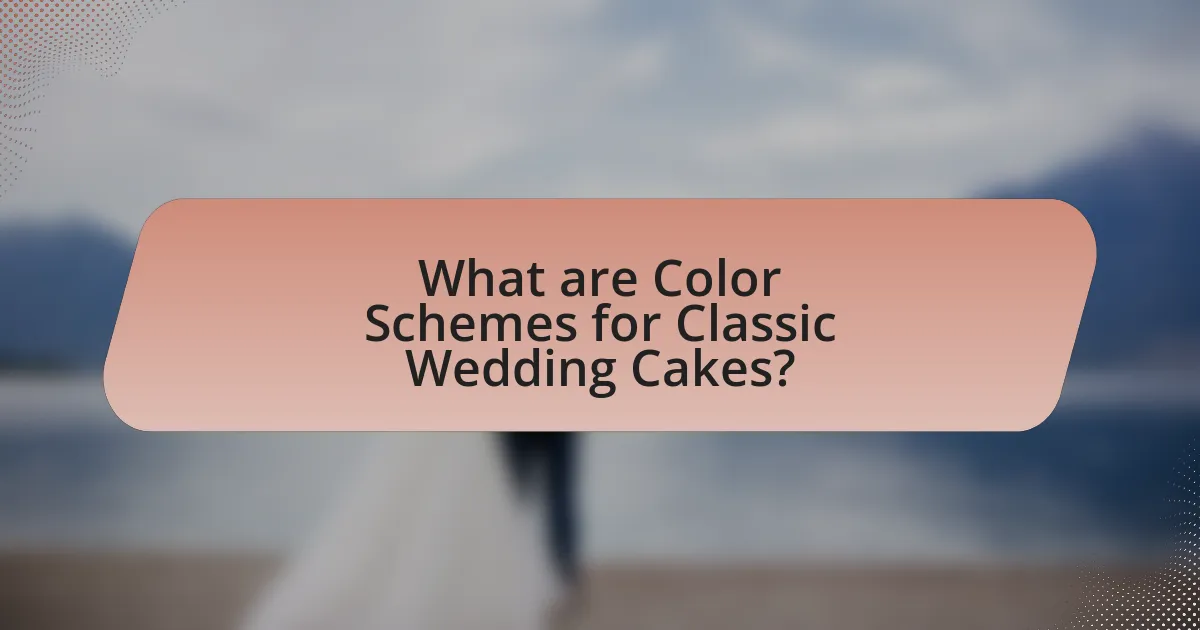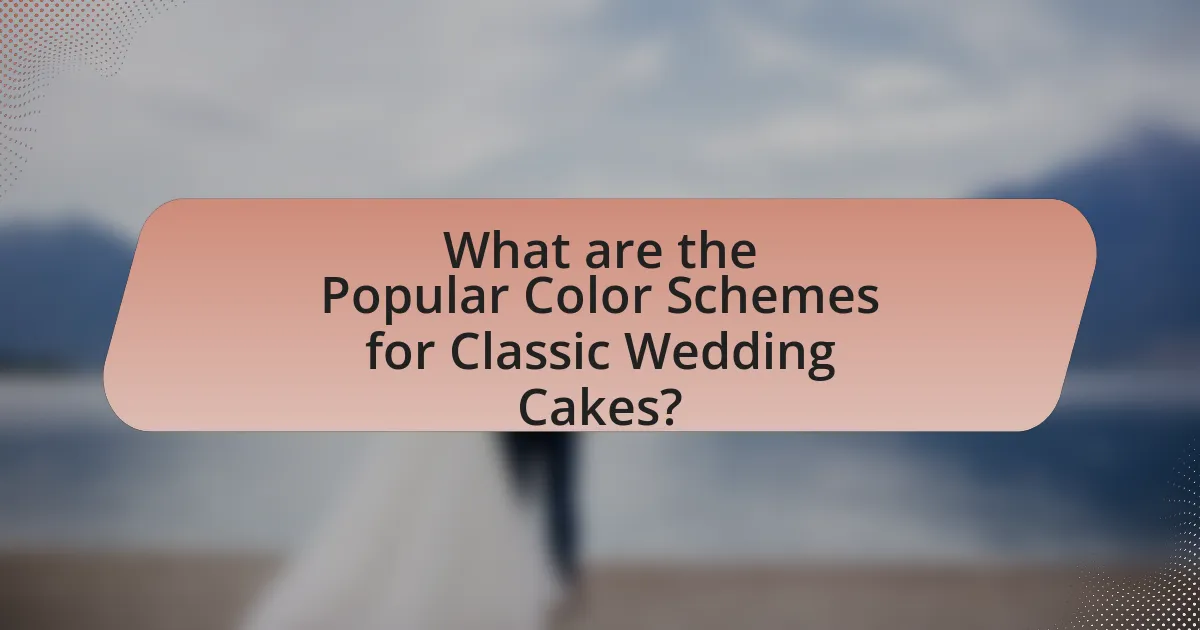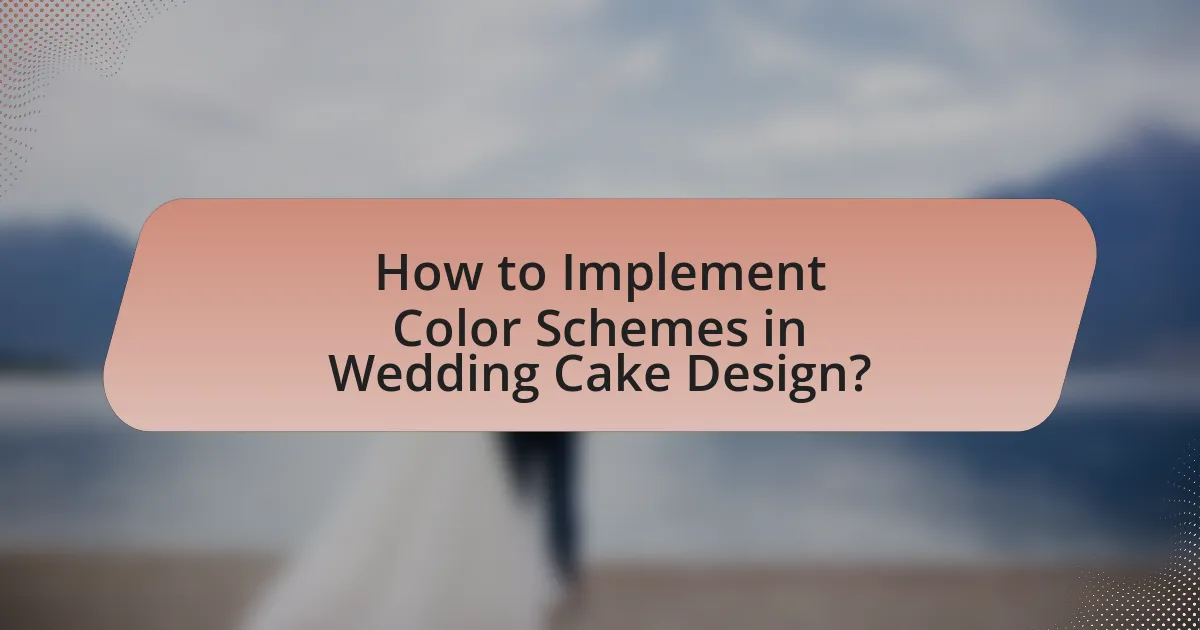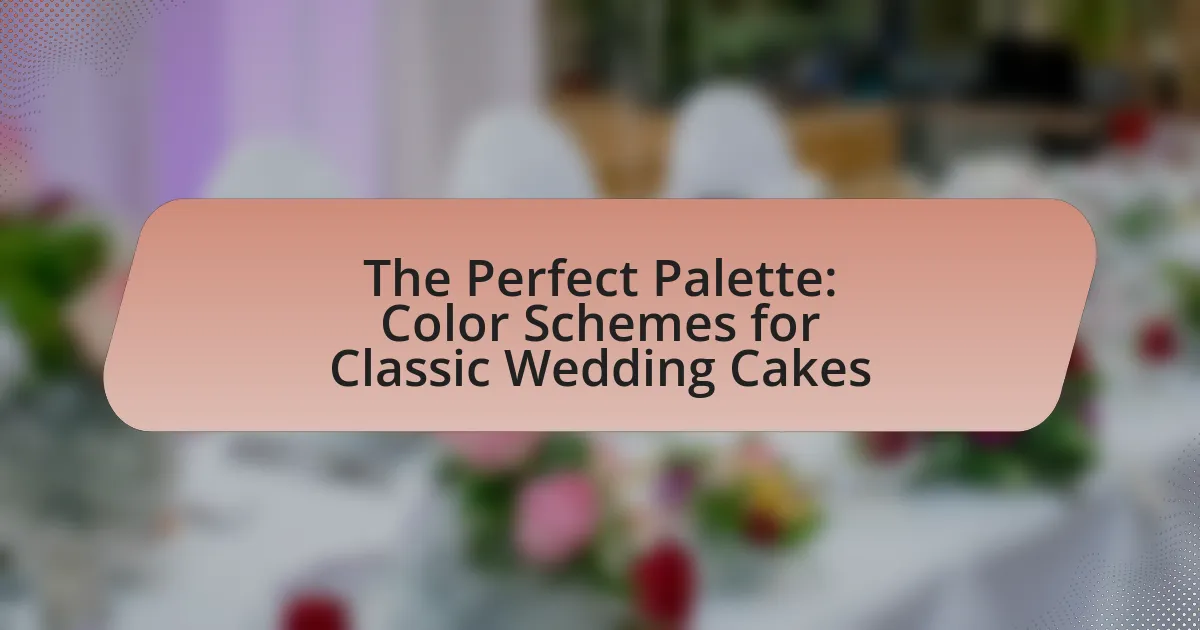The article focuses on color schemes for classic wedding cakes, emphasizing their role in enhancing elegance and thematic coherence. It explores popular combinations such as white and ivory, blush pink and gold, and rich jewel tones, while discussing how color choices influence the overall design and emotional tone of the cake. Key elements of successful color schemes, including harmony, contrast, and balance, are outlined, along with techniques for incorporating colors into cake designs. The article also highlights the importance of aligning color palettes with wedding themes, seasonal influences, and floral arrangements to create a cohesive aesthetic.

What are Color Schemes for Classic Wedding Cakes?
Classic wedding cakes typically feature color schemes that evoke elegance and timelessness. Common color combinations include white and ivory, which symbolize purity and sophistication, often accented with gold or silver for a touch of luxury. Additionally, soft pastels like blush pink, lavender, and mint green are popular for a romantic feel, while bolder colors such as deep red or navy blue can add drama and richness. These color schemes are often chosen to complement the overall wedding theme and floral arrangements, ensuring a cohesive aesthetic throughout the celebration.
How do color schemes influence the overall design of wedding cakes?
Color schemes significantly influence the overall design of wedding cakes by dictating the visual appeal and thematic coherence of the cake. The choice of colors can evoke specific emotions and set the tone for the wedding, as colors like soft pastels often convey romance, while bold hues can express vibrancy and celebration. Additionally, color schemes help in harmonizing the cake with other wedding elements, such as floral arrangements and table settings, ensuring a cohesive aesthetic. Research indicates that color psychology plays a crucial role in consumer preferences, suggesting that the right color combinations can enhance the perceived quality and desirability of the cake.
What are the key elements of a successful color scheme?
A successful color scheme consists of harmony, contrast, and balance. Harmony ensures that colors complement each other, creating a cohesive look; for example, analogous colors, which are next to each other on the color wheel, often work well together. Contrast adds visual interest and can highlight specific elements; using complementary colors, which are opposite each other on the color wheel, can achieve this effect. Balance involves distributing colors evenly throughout the design to avoid overwhelming any single area, often achieved through the 60-30-10 rule, where 60% is a dominant color, 30% a secondary color, and 10% an accent color. These elements collectively contribute to an aesthetically pleasing and effective color scheme, essential for creating visually appealing wedding cakes.
How do colors evoke emotions in wedding cake design?
Colors evoke emotions in wedding cake design by influencing the psychological responses of individuals through color psychology. For instance, soft pastels like blush pink and lavender are often associated with romance and tranquility, making them popular choices for weddings. In contrast, bold colors such as deep red can symbolize passion and love, while white typically represents purity and innocence. Research indicates that colors can trigger specific emotional reactions; for example, a study published in the journal “Color Research and Application” found that warm colors tend to evoke feelings of warmth and comfort, while cool colors can create a sense of calmness. Therefore, the selection of colors in wedding cake design plays a crucial role in conveying the desired emotional tone of the celebration.
Why is choosing the right color palette important for wedding cakes?
Choosing the right color palette for wedding cakes is crucial because it enhances the overall aesthetic of the wedding and reflects the couple’s personal style. A well-chosen color scheme can harmonize with the wedding theme, creating a cohesive visual experience that resonates with guests. For instance, studies in color psychology indicate that colors evoke specific emotions; soft pastels may convey romance, while bold hues can express vibrancy and energy. Therefore, selecting colors that align with the desired atmosphere can significantly impact the event’s ambiance and guests’ perceptions.
What impact does color have on the theme of a wedding?
Color significantly impacts the theme of a wedding by influencing the overall mood, style, and aesthetic coherence of the event. Specific colors evoke particular emotions and associations; for example, white symbolizes purity and elegance, while red conveys passion and love. The chosen color palette can unify various elements of the wedding, such as floral arrangements, attire, and decor, creating a harmonious visual experience. Research indicates that color psychology plays a crucial role in human perception and emotional response, supporting the idea that the right color scheme can enhance the celebratory atmosphere of a wedding.
How can color choices reflect the couple’s personality?
Color choices can reflect a couple’s personality by showcasing their individual preferences, values, and emotional connections to specific hues. For instance, a couple that selects vibrant colors like red and orange may indicate a passionate and energetic relationship, while softer tones like pastels can suggest a more romantic and gentle dynamic. Research in color psychology supports this, indicating that colors evoke specific emotions and traits; for example, blue is often associated with calmness and stability, which may reflect a couple’s desire for a harmonious partnership. Thus, the chosen color palette for a wedding cake can serve as a visual representation of the couple’s unique identity and relationship dynamics.

What are the Popular Color Schemes for Classic Wedding Cakes?
Popular color schemes for classic wedding cakes include white and ivory, blush pink and gold, navy blue and silver, and pastel shades. These combinations are favored for their elegance and timeless appeal. For instance, white and ivory create a sophisticated look, while blush pink and gold add a romantic touch. Navy blue and silver provide a modern contrast, and pastel shades offer a soft, whimsical feel. These color schemes are often chosen to complement the overall wedding theme and decor, ensuring a cohesive aesthetic throughout the celebration.
What are the trending color palettes for wedding cakes this season?
The trending color palettes for wedding cakes this season include soft pastels, rich jewel tones, and earthy neutrals. Soft pastels, such as blush pink, lavender, and mint green, create a romantic and delicate aesthetic, while rich jewel tones like emerald green, sapphire blue, and deep burgundy add a luxurious and bold touch. Earthy neutrals, including taupe, beige, and sage, provide a modern and understated elegance. These trends reflect current wedding themes that emphasize personalization and natural elements, aligning with the growing preference for unique and meaningful celebrations.
How do seasonal colors affect wedding cake designs?
Seasonal colors significantly influence wedding cake designs by dictating the color palette and decoration styles that align with the time of year. For instance, spring often features pastel shades like soft pinks and greens, while autumn may showcase rich hues such as deep oranges and burgundies. These seasonal palettes not only enhance the visual appeal of the cake but also create a cohesive theme that resonates with the overall wedding decor. Research indicates that color psychology plays a role in how guests perceive the cake, with certain colors evoking specific emotions and atmospheres, thereby reinforcing the wedding’s seasonal ambiance.
What classic color combinations remain timeless for wedding cakes?
Classic color combinations that remain timeless for wedding cakes include white and gold, blush and ivory, and navy and silver. These combinations are favored for their elegance and versatility, making them suitable for various wedding themes. For instance, white and gold evoke a sense of luxury and sophistication, while blush and ivory create a soft, romantic atmosphere. Navy and silver provide a striking contrast that adds depth and richness to the cake design. These color pairings have been popular in wedding aesthetics for decades, reinforcing their status as classic choices.
How can couples choose a color scheme that complements their wedding theme?
Couples can choose a color scheme that complements their wedding theme by first identifying the overall mood and style they wish to convey, such as romantic, rustic, or modern. Once the theme is established, they should select colors that align with that mood; for example, soft pastels for a romantic theme or earthy tones for a rustic vibe. Research indicates that color psychology plays a significant role in emotional responses, so couples can enhance their theme by choosing colors that evoke the desired feelings. For instance, blue is often associated with calmness, while red can signify passion. Additionally, couples should consider seasonal colors that naturally fit their wedding date, as this can create a cohesive look. By integrating these elements, couples can effectively select a color scheme that enhances their wedding theme.
What role does the wedding venue play in color selection?
The wedding venue significantly influences color selection by providing a backdrop that can enhance or limit color choices. The architectural style, decor, and natural surroundings of the venue dictate which colors will harmonize with the environment, ensuring that the overall aesthetic is cohesive. For example, a rustic barn may inspire earthy tones, while a beach venue might lead to a palette of soft pastels or vibrant blues. Additionally, the lighting conditions within the venue can affect how colors appear, making it essential to consider these factors when selecting a color scheme for wedding cakes.
How can floral arrangements influence cake color choices?
Floral arrangements can significantly influence cake color choices by providing a visual reference for complementary or contrasting hues. The colors of the flowers, whether vibrant or pastel, can guide the selection of cake frosting and decoration to create a cohesive aesthetic. For instance, if a floral arrangement features deep red roses, a cake in a soft cream or white with red accents can enhance the overall presentation. Studies in color theory indicate that colors evoke emotions and perceptions, which can be strategically used in wedding planning to create harmony between the cake and floral elements.

How to Implement Color Schemes in Wedding Cake Design?
To implement color schemes in wedding cake design, start by selecting a color palette that aligns with the wedding theme and season. For instance, pastel colors are often chosen for spring weddings, while rich jewel tones may suit fall celebrations. Once the palette is established, incorporate these colors through fondant, buttercream, or edible decorations like flowers and ribbons. For example, a cake can feature a base color of ivory with accents of blush pink and gold, creating a cohesive look. Research indicates that color psychology plays a significant role in wedding aesthetics, with certain colors evoking specific emotions, thus enhancing the overall experience for guests.
What techniques can bakers use to incorporate colors into cake designs?
Bakers can incorporate colors into cake designs using techniques such as airbrushing, fondant application, and edible paints. Airbrushing allows for smooth, gradient color effects and can cover large areas quickly, making it ideal for creating ombre or multi-colored designs. Fondant can be tinted with gel food coloring before rolling out, enabling bakers to create vibrant decorations like flowers or ribbons that match specific color schemes. Edible paints, which are often made from food-safe pigments, can be used to add intricate details and designs directly onto the cake surface, enhancing visual appeal. These methods are widely used in the baking industry, as they provide versatility and precision in achieving desired color effects.
How can fondant and icing be colored effectively?
Fondant and icing can be colored effectively by using gel or paste food colorings, which provide vibrant hues without altering the texture. These concentrated colorings allow for precise control over the shade, enabling bakers to achieve the desired color intensity. For optimal results, it is recommended to knead the color into the fondant or icing thoroughly until uniform, ensuring even distribution. Additionally, starting with a small amount of color and gradually adding more allows for better control over the final shade. This method is supported by the fact that gel colors are more concentrated than liquid colors, making them ideal for achieving rich, deep colors without compromising the consistency of the fondant or icing.
What are the best practices for using edible colors and dyes?
The best practices for using edible colors and dyes include selecting high-quality, food-safe products, understanding the concentration levels for desired shades, and testing colors on a small sample before applying them to the entire cake. High-quality edible colors ensure safety and vibrancy, while knowing concentration levels helps achieve the intended hue without over-saturation. Testing allows for adjustments and prevents unexpected results. Additionally, using gel or paste colors is often recommended over liquid dyes, as they provide more intense colors without altering the cake’s consistency.
What are some common mistakes to avoid when selecting a color scheme?
Common mistakes to avoid when selecting a color scheme include failing to consider the overall theme and setting of the wedding, which can lead to a disjointed aesthetic. Additionally, neglecting to test color combinations can result in clashing hues that detract from the cake’s visual appeal. Overcomplicating the palette with too many colors can create confusion and overwhelm the design, while not accounting for seasonal influences may lead to choices that feel out of place. Lastly, ignoring the psychological effects of colors can impact guests’ perceptions and emotions, making it crucial to choose shades that evoke the desired atmosphere.
How can over-saturation of colors affect the cake’s appearance?
Over-saturation of colors can make a cake appear visually overwhelming and unappealing. When colors are excessively bright or intense, they can clash, detracting from the overall aesthetic and elegance typically desired in wedding cakes. Research indicates that color theory suggests that harmonious color combinations enhance visual appeal, while over-saturation can lead to a chaotic look that may not align with the sophisticated themes often sought in wedding designs.
What should couples consider to ensure color harmony?
Couples should consider the color wheel and complementary colors to ensure color harmony. Utilizing the color wheel allows couples to identify colors that work well together, such as complementary colors that are opposite each other, or analogous colors that are next to each other. Research indicates that color harmony can enhance visual appeal and emotional response, making it crucial for wedding aesthetics. For example, a study published in the Journal of Color Research and Application highlights that harmonious color combinations can evoke positive feelings and create a cohesive look, which is essential for events like weddings.
What tips can help couples finalize their wedding cake color scheme?
Couples can finalize their wedding cake color scheme by considering their overall wedding theme and color palette. Aligning the cake colors with the wedding’s primary colors ensures visual harmony, as studies show that cohesive color schemes enhance aesthetic appeal. Additionally, couples should take into account seasonal colors; for instance, pastel shades are popular in spring, while rich jewel tones are favored in fall. Finally, sampling cake designs and colors through consultations with bakers can provide practical insights, allowing couples to visualize how different colors will work together on the cake.
